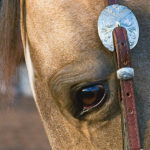Just picture it (and maybe you have): the grand horse farm, perfectly designed and sited, and blessed with every amenity you and your horses could ever need or want. Total showplace, magazine cover-worthy, there’s even a hot tub for the horses! And this the very place where you have your horses now, right?

Um, probably not. Most of us who keep and care for horses, especially at home, don’t have or even prioritize grandeur. But practicality? That’s a different story. You’re probably always looking for ways to lighten the hard work, make things safer (vet bills add up!), and cost less in the long run. You may even have an annual budget for getting such things accomplished, one project at a time. (If so, we salute you!) Here, gleaned from our network of readers and other horse friends, are 15 keep-it-real ideas for improvements that they’ve loved. When you find an idea that clicks for you, a few clicks will tell you more: Enter the boldface terms into an online search engine for further information and to find suppliers.
Convenience Devices
Like an automatic dishwasher in the kitchen, these are improvements you could get along without, but at a cost of additional daily labor.
1. Automatic horse waterer. Imagine a no-hose horse life, and no need to refill buckets and water troughs twice a day. And water that’s fresh when a horse wants it. You can have all these benefits with an automatic unit that provides horses water on demand. Some are designed for wall- or pedestal-mounting in stalls and pens, and others can be placed out in the open, as in a pasture. You’ll still need to check and clean your waterer(s) on a regular basis, but the hose drag (and worse, the frozen hose) will be a thing of the past. I happen to have these in my barn and love them.
2. Automatic horse feeder. An outgrowth of the pet-care industry, this type of device can come in very handy for the horse owner who must work odd hours or be gone past feeding time on occasion. Some units dispense grain and concentrates, while others can be programmed to deliver flakes of hay as often as six times a day. Most are designed to feed just a single horse at a time, and are ideal for horses with individual stalls or pens.
3. Barn hot water. The traditional way to add this feature is with an electric water heater and the plumbing to support it. However, using a garden hose for the water source and portable propane to heat water as it passes through a tankless heater with exit nozzle, you can have hot water at the barn (or at a show) without electricity or a plumber. Popular for cabins and campgrounds, these non-electric units vary in size and capacity. Some come on dolly carts for ease of moving from place to place.
4. Horse fly-misting system. This can be as small as a wall-mount, battery-timed, spray-can mister that you activate when and where needed (in your grooming area, for instance), or large enough for 24/7 insect control of an entire barn. The former resembles an aerosol room mister that uses replacement canisters, while the latter type usually stores water-based insecticide in a 55-gallon barrel, dispensing it at timed intervals via multiple mister tubes and nozzles installed where needed.
Pre-Fab Components
Prefabricated parts of a whole can make relatively easy work of numerous farm improvements. They also allow you to make improvements incrementally, as you can afford it
5. Stall fronts. This includes the whole category of prefab stall components, which you’ll find with a stall fronts search. However, the fronts themselves have the most variables in function, depending on brand and style chosen. You can get grillwork; Dutch doors; full-entry doors that slide or swing open; feed doors that slide, swing, or drop down; built-in blanket/ halter hangers; even pet-door inserts. A stall-front upgrade is one of the fastest ways to change the face and functionality of your barn aisle.
6. Stall mats. As with stall fronts, this search term yields a range of products. All involve flooring systems for equine application. These products, often made of rubber, can be used to line the floors of stalls, trailers, alleyways, grooming/hoof-care areas, and washracks. Until you’ve lived with matted stalls, you probably won’t realize how much time and effort you previously put into maintaining dirt-floor stalls and their inevitable holes and sloppy craters. The savings on bedding is also quite considerable.
7. Horse fence panels. Available in various lengths from 10 to 16 feet, metal fence panels can be connected to create pens, runs, riding arenas, or even an overnight horse-camping corral. They allow you to reconfigure space as needed. They’re sturdy, impervious to horses acting like gnawing beavers, and may minimize the need for posts. They’re also widely available at farm/ranch stores around the country and if well made, will last for decades.
8. Horse gates. You might be surprised by how much functionality you can add to your place just by changing its gates. Especially handy: Gates that can be opened and relatched with just one hand, leaving the other free for controlling the horse; and gate-in-a-gate styles that allow handler entrance through one while the main gate remains closed.
Fencing, Fixtures
You can’t go wrong by improving your fencing, barnyard lighting, and means of preventing mud.
9. Horse fencing. Hands down, this is the key component of any horse property and thus a major area for maintenance, repairs, replacement, and expansion. Your improvements here will keep your horses safer, boost property value, and provide peace of mind. This is a relatively large product category with many choices to consider and planning to do before you buy. (See Fence Planning, June 2013.) For inspiration: One of my best farm improvements was to replace three-rail wood with woven mesh in pasture areas that border unfarmed fields. Besides keeping horses in and needing little maintenance, the new fence also helps to keep wildlife and stray dogs out.
10. T-post caps. If you use metal T-posts anywhere on your horse property, topping them with plastic safety caps is a must. While economical and easy to install, these posts pose a risk should a horse run into or rear and come down on an unprotected metal top turned into a spear. Most brands of T-post caps also feature a holder for single-strand electric fencing wire. This allows you to electrify enclosures without needing to buy additional hardware.
11. Motion-sensor light. Available in wired and wireless models, a motion-sensor light comes on automatically and is a fast, easy way to add convenience to your horse property. Install one above your barn entrance, for instance, and you’ll never have to fumble your way inside in the dark. The light will come on as you approach. Ditto as you back up in the dark with a trailer of hay to unload. By placing a motion-sensor light near your trailer-parking or unloading area, you’ll gain valuable light for duties there. And if you’re concerned about nighttime intruders, motion-sensor lights can be an effective deterrent.
12. Barn gutters. Unless you live in an area where mud is never a problem (lucky you!), adding rain gutters to your structures will make you wonder how you ever got along without them. They catch rainwater as it falls from your barn?s roof and direct it someplace other than adjacent corrals or stall runs. Guttering supplies are readily available from any building supplier or big-box home-improvement store.
Equipment
Good equipment helps fix problems and prevents them from developing in the first place.
13. Horse-pasture feeder. Once upon a time, pasture feeders (free-standing equipment for feeding hay to livestock in groups) were designed for cattle only. But today, manufacturers have designed and produced this equipment with horses in mind. By investing in a well-designed pasture feeder, you’ll reduce the amount of wasted hay and cut injury potential as well, for long-term savings on feed and vet bills.
14. Horse-farm tractor. While it can be done, it’s challenging to keep up with a horse property?s requirements without some kind of tractor. The good news here is that tractors and implements are available for small acreages as well as large ones. A dealership can create an equipment package tailored to your needs, and may offer a financing plan as well.
15. Arena groomer. Do you have a way to drag, fluff, and otherwise groom the footing in your training area? If not, your horses would thank you for investing in an arena groomer. Some are simple enough to be hooked to the back of a large garden tractor, and many power/function upgrades exist from there. Of all the equipment purchased for my own horsekeeping property, I’d say the arena groomer is one of its main workhorses.





